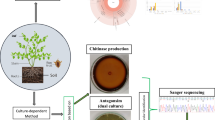Abstract
Forty-three strains of Eupenicillium tropicum sp. nov. were isolated from soils collected in India, Costa Rica and Galapagos, Ecuador. The species is characterized by biverticillate penicilli, slightly rough, subglobose to ovate conidia, brownish cleistothecia that become brown-gray with age, and ascospores with two equatorial flanges and slightly roughened valves. All strains produced a large number of indole alkaloids, and many types of unknown secondary metabolites with characteristic chromophores were produced by a majority of strains. Eupenicillium tropicum is morphologically most similar to E. shearii, but based on ITS-LSU sequences, is most closely related to Penicillium citrinum, P. sartoryi and P. westlingii. Eupenicillium shearii strains consistently produce paxillin, paspalinine and shearinins, while the latter three penicillia all produce citrinin consistently.
Similar content being viewed by others
References
Belofsky GN, Gloer JB, Wicklow DT, Dowd PF (1995) Anti-insectan alkaloids. Shearinines A-C and a new paxilline derivative from the ascostromata of Eupenicillium shearii. — Tetrahedron 51: 3959–3968.
Christensen M, Miller SL, Tuthill D (1994) Colour standards: a review and evaluation in relation to Penicillium taxonomy. — Mycological Research 98: 635–644.
Christensen M, Frisvad JC, Tuthill D (1999) Taxonomy of the Penicillium miczynskii group based on morphology and secondary metabolites. — Mycological Research 103: 527–541.
Frisvad JC, Filtenborg O (1990) Revision of Penicillium subgenus Furcatum based on secondary metabolites and conventional characters. In: Samson RA, Pitt JI, eds. Modern concepts in Penicillium and Aspergillus classification, pp. 159–170. Plenum Press, New York.
Frisvad JC, Thrane U (1987) Standardized high-performance liquid chromatography of 182 mycotoxins and other fungal metabolites based on alkylphenone retention indices and UV-VIS spectra (diode-array detection). — Journal of Chromatography 404: 195–214.
Kuramoto M, Yamada K, Shikano M, Yazawa K, Arimoto H, Okamura T, Uemura D (1997) Tanzawaic acids A, B, C, and D: inhibitors of superoxide anion production from Penicillium citrinum. — Chemistry Letters 1997: 885–886.
Malstrom J, Christophersen C, Frisvad JC (2000) Secondary metabolites characteristic of Penicillium citrinum, Penicillium steckii and related species. — Phytochemistry 54: 301–309.
Nielsen KF, Smedsgaard J (2003) Fungal metabolite screening: database of 474 mycotoxins and fungal metabolites for dereplication by standardized liquid chromatography-UV-mass spectrometry methodology. — Journal of Chromatography A 1002: 111–136.
Peterson SW (2000) Phylogenetic analysis of Penicillium species based on ITS and LSU-rDNA nucleotide sequences. In: Samson RA, Pitt JI, eds. Integration of modern taxonomic methods for Penicillium and Aspergillus classification, pp 163–178. Hargrove Academic Publishers, Amsterdam.
Pitt JI (1979) The genus Penicillium and its teleomorphic states Eupenicillium and Talaromyces. Academic Press, London.
Ridgway R (1912) Color standards and color nomenclature. Selfpublished, Washington.
Samson RA, Hoekstra ES, Frisvad JC, Filtenborg O, eds. (2002) Introduction to food-and airborne fungi. Sixth edition. Centraalbureau voor Schimmelcultures, Utrecht.
Smedsgaard J (1997) Micro-scale extraction procedure for standardized screening of fungal metabolite production in culture. — Journal of Chromatography A 760: 264–270.
Stolk AC, Samson RA (1983) The ascomycete genus Eupenicillium and related Penicillium anamorphs. — Studies in Mycology 23: 1–149.
Swofford DL (1998) PAUP*. Phylogenetic analysis using parsimony (*and other methods). Version 4.0b1 Sinauer Associates, Sunderland, MA.
Thompson JD, Gibson TJ, Plewniak F, Jeanmougin F, Higgins DG (1997) The ClustalX windows interface: flexible strategies for multiple sequence alignment aided by quality analysis tools. — Nucleic Acids Research 24: 4876–4882.
Tuthill, DE (2003) Genetic variation and recombination in Penicillium miczynskii and Eupenicillium species. — Mycological Progress 3: 3–12.
Tuthill DE, Frisvad JC (2002) Eupenicillium bovifimosum, a new species from dry cow manure in Wyoming. — Mycologia 94: 240–246.
Author information
Authors and Affiliations
Rights and permissions
About this article
Cite this article
Tuthill, D.E., Frisvad, J.C. A new species from tropical soils, Eupenicillium tropicum . Mycol Progress 3, 13–18 (2004). https://doi.org/10.1007/s11557-006-0071-2
Accepted:
Issue Date:
DOI: https://doi.org/10.1007/s11557-006-0071-2




